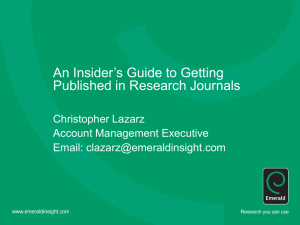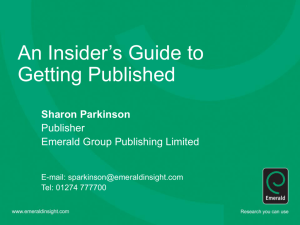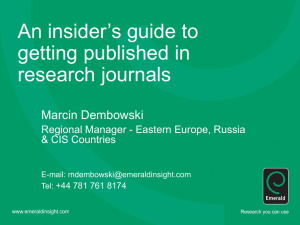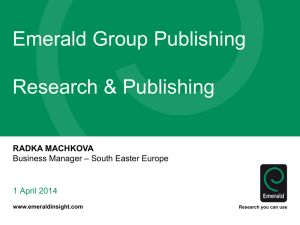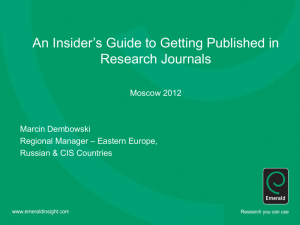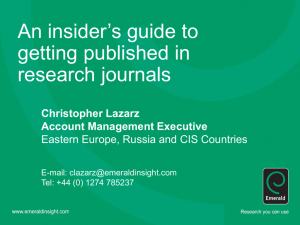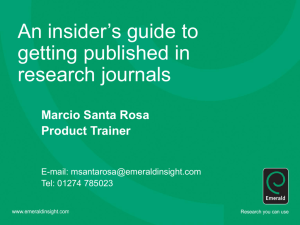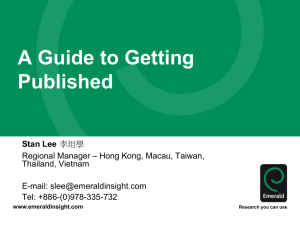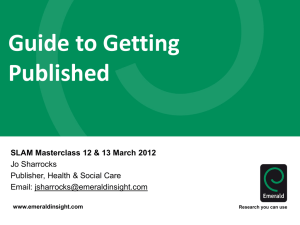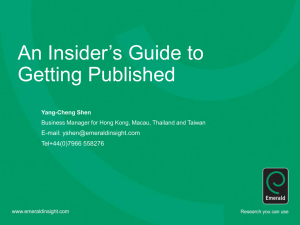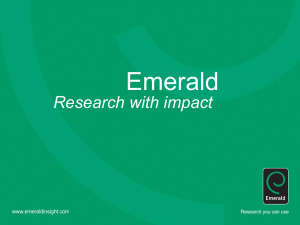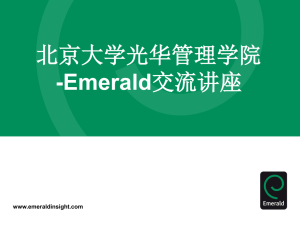Document
advertisement
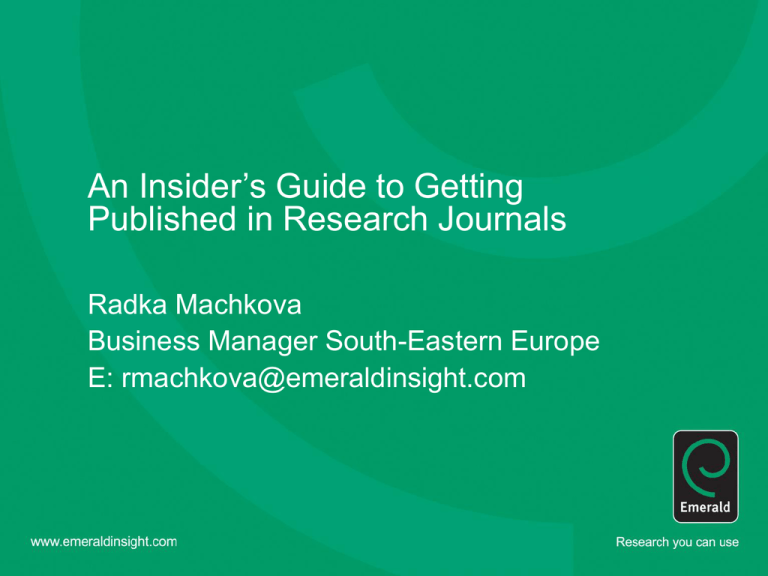
An Insider’s Guide to Getting Published in Research Journals Radka Machkova Business Manager South-Eastern Europe E: rmachkova@emeraldinsight.com Aims of the session 1st Part • Who is Emerald Group Publishing? • Our product portfolio of eJournals, eBooks and Case Studies 2nd Part • Explain what happens ‘behind the scenes’ at a publishing house • Provide tips, inside knowledge and answer your key questions • Discuss journal quality measures • Help you avoid desk rejects • Maximise your chances of publication • Q&A session: ask anything! • Follow-up: we’re always available to help Emerald – who we are • A leading independent publisher of business management & economics disciplines, library and information studies; engineering, education & social science research • We publish research which makes a significant contribution to practice • Formed in UK 1967 West Yorkshire • Publishing offices in US, UK, China, India and Malaysia, Canada, Dubai, Brazil, Japan and Australia • 290+ peer reviewed journals (54 in ISI and over 160 in Scopus) • 2000+ book series, e-books, stand-alone volumes “Research you can use” Emerald is … • International – Over 3000 university libraries worldwide, including all of the FT top business schools – Potential readership of over 20 million • Inclusive – theory and practice, rigour and relevance – Supportive of scholarly research • Committed to improve author and reader experiences • Concerned about globally responsible publishing – We believe the world needs better management and we publish materials to reach this goal Emerald is proud to say that: Financial Times Top 100 Business Schools Over 90 of the FT top 100 business schools worldwide are Emerald customers We have authors from all of the FT top 100 business schools worldwide In 2010 the FT top 100 business schools worldwide downloaded Emerald articles 1.4m times – an average of 14,000 per school! Times Higher Education Supplement World University Rankings 2010 We have authors from 199 of the THES top 200 universities worldwide In 2010 the THES top 200 universities worldwide downloaded Emerald articles 3m times – that’s 15,000 per school! We publish in 25 subject areas 2012 we publish over 290 eJournals, over 100 eBooks Series and over 300 Case Studies in 25 subject collection collections Every year we expand portfolio – new launches & acquisitions • Accounting and Finance • Built Environment • Business Ethics and Law • Economics • Education • Enterprise and Innovation • Engineering • Environment/ Environmental Studies • Health Care Management • Human Resource Management • Industry and Public Sector Management • Information and Knowledge Management Emerald Management eJournal Subject • • • • • • • • • • • • • International Business Learning and Development Library and Information Studies Management Science/Mngmnt Studies Managing Quality Marketing Operations and Logistics Management Organization Studies Performance Mngmnt & Measurement Regional Management Studies Sociology Strategy Tourism and Hospitality Collection brochure. Did you know? Emerald firsts – we published the first reference to the World Wide Web in 1992 in Electronic Networking, now called Internet Research Emerald globally – we are a truly global publisher, having invested in staff and offices in 16 countries worldwide, which brings us closer than ever to our research and library communities Emerald Literati – over 100,000 researchers, academics and authors have contributed to our journals and books since 1994 Emerald innovation – we’ve launched a number of ground-breaking new journals, including the world’s first journal on Islamic Finance International Journal of Islamic and Middle Eastern Finance and Management - in 2008 2nd Part Emerald Publishing Standards All of our journals are peer reviewed to ensure quality We follow the policies of COPE (Committee of Publishing Ethics) We are compliant with TRANSFER when acquiring or selling journals We use iThenticate® software to combat plagiarism Editorial supply chain and journal management structure: journals Author Quality research papers Editor EAB and reviewers Solicits new papers Research Handles review process Promotes journal to peers Publisher/ Managing Editor The link between the publishing company and editor Production QA – sub-editing and proof reading Access via library Convert to SGML for online databases Hard copy Helps editors succeed in their role and build a first class journal Print production Overall responsibility Despatch for journal Attends conferences Promotion and marketing Develops new areas of coverage Attends conferences Handles production issues Users Added value from publisher Database Third party Publishing your research – where to begin? • Are you working on a Doctoral or Master’s thesis? • Have you completed a project which concluded successfully? • Are you wrestling with a problem with no clear solution? • Do you have an opinion or observation about business practice? • Have you given a presentation or conference paper? If so, you have the basis for a publishable paper Research is all about peer review 1. You need to avoid a desk reject 2. You may need to revise and resubmit 3. You will almost certainly need to alter your paper ‘Journals are ongoing conversations between scholars’ (Lorraine Eden) • Study the author guidelines, and read the journal, to understand the conversation • You will be ‘desk rejected’ if you appear to be unaware of what has being said, or why you are submitting Target! “Many papers are desk rejected because they simply don’t fulfil journal requirements. They don’t even go into the review process.” • Identify a few possible target journals but be realistic • Follow the Author Guidelines: scope, type of paper, word length, references style, etc • Find where to send your paper (editor, regional editor, subject area editor) … • … and how to send it (email, hard copy, online submission) • Send an outline or abstract to editor: is it suitable? how can it be made so? • Read at least one issue of the journal Example of author guidelines Every journal published will have detailed notes and guidelines Plagiarism and referencing • Plagiarism (from the Latin plagium meaning ‘a kidnapping’) is the act of taking someone else’s work and pretending it is yours. It is considered fraud! • It isn’t always detected in peer review but electronic tools can help • Emerald’s entire portfolio is included in iThenticate web-based software from iParadigms (http://www.ithenticate.com) • View Emerald’s Plagiarism Policy online (http://info.emeraldinsight.com/about/ policies/plagiarism.htm) Copyright • As the author, you need to ensure that you get permission to use content you have not created • If you don’t, it may delay your paper being published • Supply written confirmation from the copyright holder when submitting your manuscript • If permission cannot be cleared, we cannot republish that specific content • More information including a permissions request form is available at: http://info.emeraldinsight.com/authors/writing/ permissions.htm What editors and reviewers look for • Relevance to the editorial scope and objectives • Originality – what’s new about subject, treatment or results? • Position your paper – does it build on existing theory, provide a new perspective, or put a theory to an empirical test? • Clarity and quality of writing – does it communicate well? • Case study – no ‘war stories’ or advertorials. Be honest about problems you encountered – it makes a better article • Practical implications – the ‘so what?’ factors • Conclusions – are they valid and objective? • Good, short title, keywords and abstract Thomson Reuters (ISI) • Thomson Reuters’ The ‘Web of Science’ database scores 12,000 selected journals with ‘Impact Factors’ based on journal citations • The latest Thomson Reuters statistics were published in June 2010 for the year 2009 • Journals are ranked based on how many times the articles included in that journal are cited … in other ISI-ranked journals. The ranking is published every year, in June. • ISI uses a calculation of citation data over a three year period to produce an Impact Factor for a given year. • For example, the Impact Factor for International Marketing Review is 1.164 and relates to 2009, although the figure was released in 2010. Thomson Reuters (ISI) How are Impact Factor calculations made? ISI uses the following equation to work out the impact factor: A = 2009 cites to articles published only in 2007-2008 in a given journal B = number of articles published in 2007-2008 in a given journal A/B = 2009 impact factor Journal of Management Genius 20 citations in 2009 in other ISI journals from its 2007-2008 issues (A). 60 articles published (B). Impact factor for Journal of Management Genius in 2009 was 20/60 = 0.333 A = 2009 cites (20) B = articles published (60) A/B = 2009 impact factor (0.333) Thomson Reuters (ISI) What does that mean? ISI is the most well known ranking • It determines tenure, authorship and funding in many universities worldwide BUT… • It is heavily weighted towards North America • Data gathering has been questioned • Citations are not the only way of measuring impact Other measures of quality? There are other indicators to measure quality such as: • number of downloads (utility) • dissemination of journal (where it is read) • quality of the authors • number of editors from top business schools • relevance of content and publishing ethos • links to societies/associations • internationality In your publishing, decide on your priority! • Be political (e.g. national vs international) and strategic (e.g. five articles in ‘low ranked’ journals vs one in ‘top ranked’ journal) What is ‘impact of research’? Research impacts upon these areas Some key questions • Readability – Does it communicate? Is it clear? Is there a logical progression without unnecessary duplication? • Contribution – Why was it written? What’s new? Where does it fit into the ‘conversation’? • Credibility – Are the conclusions valid? Is the methodology robust? Is it honest? Don’t hide limitations of research - you’ll be found out. • Applicability – How do findings apply to the world of practice? Does it pinpoint the way forward for future research? • Internationality – Does the paper have a global perspective? (And if not, why not?) Your own peer review Let someone else see it! We always get too close to our own work Always proof-check thoroughly – no incorrect spellings, no incomplete references. Spell checkers are not fool proof Spot the error: “A knew research methodology introduced in 2007…” Timetable from submission to initial feedback to authors • The Editor(s) do an initial read to determine if the subject matter and research approach is appropriate for the journal (approx. 1 week) • The Editor(s) identify and reviewers (approx. 1 week) • Reviewers usually have complete their reviews contact 6-8 weeks two to • The Editor(s) assess the reviewers' comments and recommendations and make a decision (approx. 2 weeks) • Expected time from submission to review feedback: 3-3.5 months Co-authorship? • With supervisor, or different departments or institutions • Exploits individual strengths • Especially useful for cross-disciplinary research • Demonstrates the authority and rigour of the research But remember • Ensure paper is checked and edited so that it reads as one voice • Agree and clarify order of appearance of authors Improving electronic dissemination • Short title containing main keyword • Clear and descriptive abstract – include main keywords and follow any instructions for content and length • Use relevant and known keywords – not obscure new jargon • Make references complete and correct – vital for reference linking and citation indices • Ensure your paper is word perfect Emerald requests structured abstracts 250 words or less (no more than 100 in any one section) • Purpose – Reasons for research, aims of paper • Design – Methodology, scope of study • Findings – Discussion, results • Research limitations/implications – Exclusions, next steps • Practical implications – The ‘so what?’ factor • Social implications – Wider benefits to society • Originality/value – Who benefits, what’s new? Process of acceptance for a journal – just one example Revising • A request for revision is good news! – You’ve avoided a desk reject and you are in the publishing cycle – Nearly every published paper is revised at least once • Acknowledge the editor and set a revision deadline • Clarify understanding if in doubt – ‘This is what I understand the comments to mean…’ • Meet the revision deadline • Attach a covering letter showing how you met the reviewers’ requests (or if not, why not) After publication, promote your work • Why? • Influence policy • Raise your profile • Attract collaborators and funding • New opportunities e.g. in consulting, the media • How? • Use your network: listservs, a press release • Link to the article in your email signature • Contact the authors in your reference list • Ask the publisher to provide you with book or journal leaflets If your paper is rejected … • Ask why, and listen carefully! Most editors will give detailed comments about a rejected paper. Take a deep breath, and listen to what is being said • Try again! Fix the paper, then submit elsewhere. Target your paper as closely as possible, and remember you might get the same reviewer again • Don’t give up! At least 50% of papers in business and management don’t get published. Everybody has been rejected at least once Typical criticisms & Possible reasons for rejections (journal dependent) • Lack of fit (‘why was it sent to this journal’?) • Problem with quality (inappropriate methodology, not reasonably rigorous, excessively long) or Insufficient contribution (does not advance the field, a minor extension of existing work) • Did you understand the “journal conversation”? • Theory development is weak (theory by assertion, or reinvention of existing theory) • Empirical work is weak (methodology not plausible, tests don’t rule out alternative hypotheses) • ‘So what’? (nothing wrong with the paper – but nothing very insightful either; only incremental research, doesn’t affect an existing paradigm) Publishing your research means… • Your paper is permanent – published material enters a permanent and accessible knowledge archive – the ‘body of knowledge’ • Your paper is improved – through the interventions of editors, reviewers, sub-editors and proof-readers • Your paper is actively promoted – it becomes available to a far greater audience • Your writing is trustworthy – material which has been published carries a QA stamp. Someone apart from you thinks it’s good! Publishing ALSO puts your work in front of the best managers of tomorrow Hong Kong UST, Indian School of Business, University of Cape Town Wharton, Harvard, Stanford, Chicago, Yale, Thunderbird Business Schools London, Lancaster, Cranfield, Warwick, Saïd, Strathclyde Business Schools IMD, INSEAD, Rotterdam, Bocconi, EM Lyon, Instituto de Empresa, ESADE, IESE Emerald Supports Authors • More then 80,000 authors from around the world are members of Emerald Literati Network • Free issue and 5 reprints of your article • For Researchers www.emeraldinsight.com/research – Outstanding Doctoral Research Awards, Research Fund Awards – How to… guides – Emerald Research Connections • For Authors www.emeraldinsight.com/authors – How to… guides – Meet the Editor interviews and Editor news – Editing service – Annual Awards for Excellence – Calls for Papers and news of publishing opportunities Other useful resources • www.isiwebofknowledge.com (ISI ranking lists and impact factors) • www.harzing.com (Anne-Wil Harzing's site about academic publishing and the assessment of research and journal quality, as well as software to conduct citation analysis) • www.scopus.com (abstract and citation database of research literature and quality web sources) • www.cabells.com (addresses, phone, e-mail and websites for a large number of journals as well as information on publication guidelines and review information) • www.phrasebank.manchester.ac.uk (a general resource for academic writers, designed primarily with international students whose first language is not English in mind) Talk to us, use us! • Tell us how we can help you • Give us feedback online • Use Emerald Management eJournals For any answers you didn’t get today (or were too shy to ask) … Contact Radka Machkova at: rmachkova@emeraldinsight.com Write for us!
